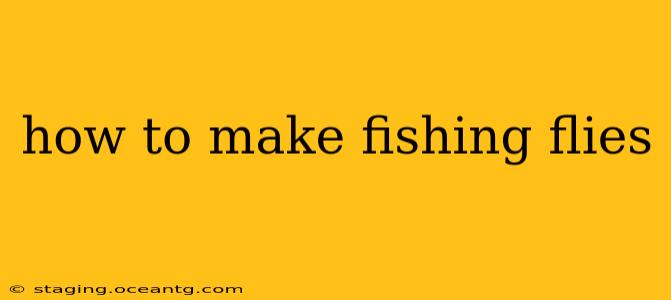Tying your own fishing flies opens up a whole new world of angling. It's a rewarding craft, allowing you to create custom lures perfectly suited to your target fish and specific fishing conditions. This comprehensive guide will walk you through the process, from gathering essential tools and materials to mastering various fly-tying techniques. Whether you're a complete beginner or looking to refine your skills, you'll find valuable insights here.
What Materials Do I Need to Make Fishing Flies?
Before you begin tying, you'll need to gather your essential tools and materials. This might seem daunting initially, but investing in quality tools will pay off in the long run. Here's a basic starter kit:
- Fly-tying vise: This holds the hook securely while you work. Choose one that's comfortable and allows for easy rotation.
- Bobbin: This holds and dispenses your thread smoothly.
- Scissors: A sharp pair of scissors is crucial for clean cuts. Consider having both a small pair for detail work and a larger pair for bulkier materials.
- Whip-finish tool: This tool helps create a secure knot at the end of your thread. While you can tie a whip finish by hand, a tool makes the process much easier and faster.
- Hackle pliers: These pliers are specialized for holding and shaping hackle feathers.
- Thread: Start with a durable, high-quality thread in a neutral color like black or brown. Different colors and thicknesses are useful as you advance.
Materials: The materials you'll need depend on the specific fly pattern you're tying. However, some common materials include:
- Hooks: Choose hooks appropriate for the type of fish you're targeting and the size of the fly.
- Floss: Used for body construction and adding color and bulk.
- Dubbing: A fluffy material used to create fuzzy bodies and legs.
- Feathers: Hackle feathers are essential for creating natural-looking wings and tails. Other feathers can add texture and movement.
- Tinsel: Adds flash and sparkle to attract fish.
- Beads: Often incorporated into nymphs and other patterns.
What are the Basic Steps to Tie a Fishing Fly?
The process of tying a fishing fly is surprisingly straightforward, although mastering it takes practice. Here's a breakdown of the basic steps:
- Prepare the Hook: Securely clamp the hook in your vise. Ensure the hook point is facing upward.
- Start the Thread: Begin tying in your thread, creating a secure base for your fly. Make several tight wraps near the hook eye.
- Construct the Body: This is where you build the bulk of your fly. Depending on your chosen pattern, you may use dubbing, floss, or other materials.
- Add the Ribbing (Optional): Ribbing, often wire or thread, adds detail and creates a segmented look to the body.
- Tie in the Hackle: Hackle feathers are attached using specific techniques to create lifelike wings and tails.
- Shape the Hackle: After tying in the hackle, carefully shape it to create the desired profile.
- Add the Head: This often involves building up the thread wraps to form a head at the front of the fly.
- Whip Finish: Securely finish off the thread using your whip-finish tool or by hand-tying a knot. Trim the excess thread.
What are Some Easy Fishing Fly Patterns for Beginners?
Starting with simple patterns helps build confidence and develop essential skills. A few easy-to-tie patterns for beginners include:
- Adams Dry Fly: This classic dry fly is relatively simple to tie and effective for trout.
- Wooly Bugger: A versatile nymph pattern that works well in various fishing conditions.
- Griffith's Gnat: Another simple dry fly pattern that’s great for beginners.
What are the Different Types of Fishing Flies?
Fishing flies are broadly categorized based on their function and where they are fished:
- Dry Flies: These float on the surface of the water, imitating insects that land on the water's surface.
- Wet Flies: These sink below the surface, imitating nymphs and submerged insects.
- Nymphs: These imitate the larval stage of insects.
- Streamers: These imitate larger insects and baitfish.
How Do I Choose the Right Fishing Fly for Different Fish?
The type of fly you choose depends largely on the species of fish you are targeting and the conditions in which you're fishing. Researching the insects and baitfish found in your fishing area will help guide your choice.
What are Some Tips for Beginners in Fly Tying?
- Practice Regularly: Consistent practice is key to developing your skills.
- Watch Videos: Online tutorials are an invaluable resource for learning different techniques.
- Start Simple: Begin with easy patterns before moving on to more complex designs.
- Invest in Quality Tools: Using quality tools makes the process easier and more enjoyable.
- Be Patient: Fly tying takes time and patience to master. Don't get discouraged if your first few attempts aren't perfect.
By following these steps and practicing regularly, you’ll soon be creating your own effective and beautiful fishing flies, enhancing your angling experience and reaping the rewards of a rewarding craft. Remember, the journey of fly tying is as much about the process as it is about the finished product. Happy tying!
